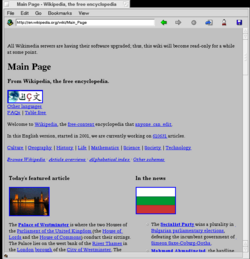NetPositive: Difference between revisions
Clarify the haiku error message link, remove 404 page implemented as NP error messages (it's redundant) |
Develop the haiku section a bit, giving two examples. |
||
| Line 22: | Line 22: | ||
It is still included in [[Magnussoft ZETA|ZETA]] as the default browser for opening saved files and links from other applications, due to unfinished implementation of the native OS bindings in [[Mozilla Firefox]] for BeOS. However, Firefox is promoted as being the primary browser on the platform. |
It is still included in [[Magnussoft ZETA|ZETA]] as the default browser for opening saved files and links from other applications, due to unfinished implementation of the native OS bindings in [[Mozilla Firefox]] for BeOS. However, Firefox is promoted as being the primary browser on the platform. |
||
===Error messages in Haiku=== |
|||
| ⚫ | The browser was notable among BeOS users due to its [[Haiku]] error messages, which lead to the name of [[Haiku (operating system)|Haiku]], an open-source BeOS clone. A late-1990's email joke which claimed that Microsoft was moving to Haiku error messages in Japanese versions of Windows was almost entirely made up of NetPositive error messages. |
||
| ⚫ | The browser was notable among BeOS users due to its [[Haiku]] error messages, which lead to the name of [[Haiku (operating system)|Haiku]], an open-source BeOS clone. A late-1990's email joke which claimed that Microsoft was moving to Haiku error messages in Japanese versions of Windows was almost entirely made up of NetPositive error messages. For instance, a user might see the following error message if they try to access a website that is unavailable: |
||
:Cables have been cut |
|||
:Southwest of Northeast somewhere |
|||
:We are not amused. |
|||
If the user tried unsuccessfully to authenticate against a website, they might see: |
|||
:Server's poor response |
|||
:Not quick enough for browser. |
|||
:Timed out, plum blossom. |
|||
==External links== |
==External links== |
||
Revision as of 16:42, 11 December 2007
 NetPositive 2.2 under BeOS R5 | |
| Developer(s) | Be Inc. |
|---|---|
| Stable release | 2.2.2
/ November 2001 |
| Operating system | BeOS |
| Type | Web browser |
| License | Proprietary |
NetPositive (often called Net+) is the default browser that comes with the BeOS operating system. It has partial support for JavaScript, but no Java or CSS support. NetPositive originally was the only web browser available for BeOS, but that is no longer the case. The last official version of NetPositive before the Be, Inc. bankruptcy was 2.2 /2.2.1 for US customers, but there also exists a 3.0d3 beta version, and a leaked 2.2.2 which changed from the RSA Encryption Engine to OpenSSL, possibly indicating that Be were cleaning the source of commercial code with an intent to open source, like the OpenTracker project.
Built binaries of NetPositive, including all encryption libraries, and other tools not provided by the OS itself, such as the HTTP and FTP engines, weigh in from 1.4 to 1.7 MB in size, uncompressed, depending on the strength of encryption provided.
NetPositive can be embedded into another application, or into the desktop of the OS itself, using the replicants system provided by the OS. When Active Desktop was launched on Windows, Microsoft promoted it as having been a major achievement. Be later claimed to have cloned the functionality using NetPositive (where Internet Explorer is used in Windows) in "nine lines of code".
A number of projects exist to clone NetPositive for BeOS, due to BeOS users' familiarity with its interface. The most advanced of these is Themis, which aims to capture the feel of NetPositive in a browser with modern features. There is also Net++, which aims to use the Gecko layout engine in the shell of the failed NetOptimist browser.
It is still included in ZETA as the default browser for opening saved files and links from other applications, due to unfinished implementation of the native OS bindings in Mozilla Firefox for BeOS. However, Firefox is promoted as being the primary browser on the platform.
Error messages in Haiku
The browser was notable among BeOS users due to its Haiku error messages, which lead to the name of Haiku, an open-source BeOS clone. A late-1990's email joke which claimed that Microsoft was moving to Haiku error messages in Japanese versions of Windows was almost entirely made up of NetPositive error messages. For instance, a user might see the following error message if they try to access a website that is unavailable:
- Cables have been cut
- Southwest of Northeast somewhere
- We are not amused.
If the user tried unsuccessfully to authenticate against a website, they might see:
- Server's poor response
- Not quick enough for browser.
- Timed out, plum blossom.
